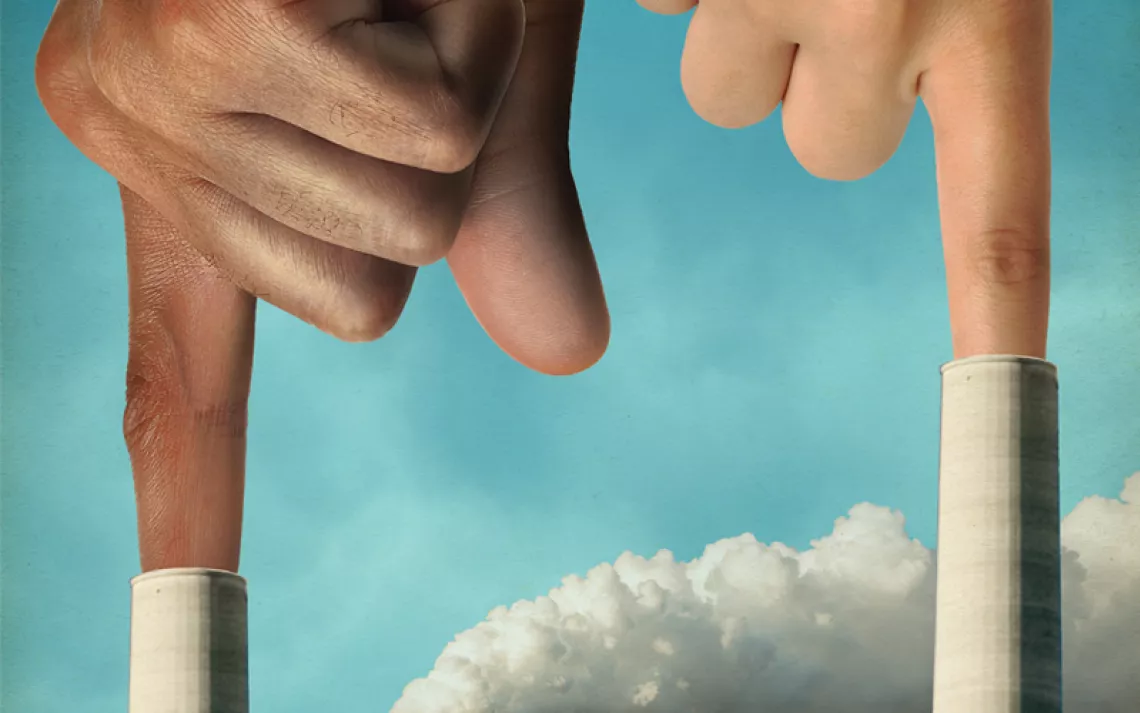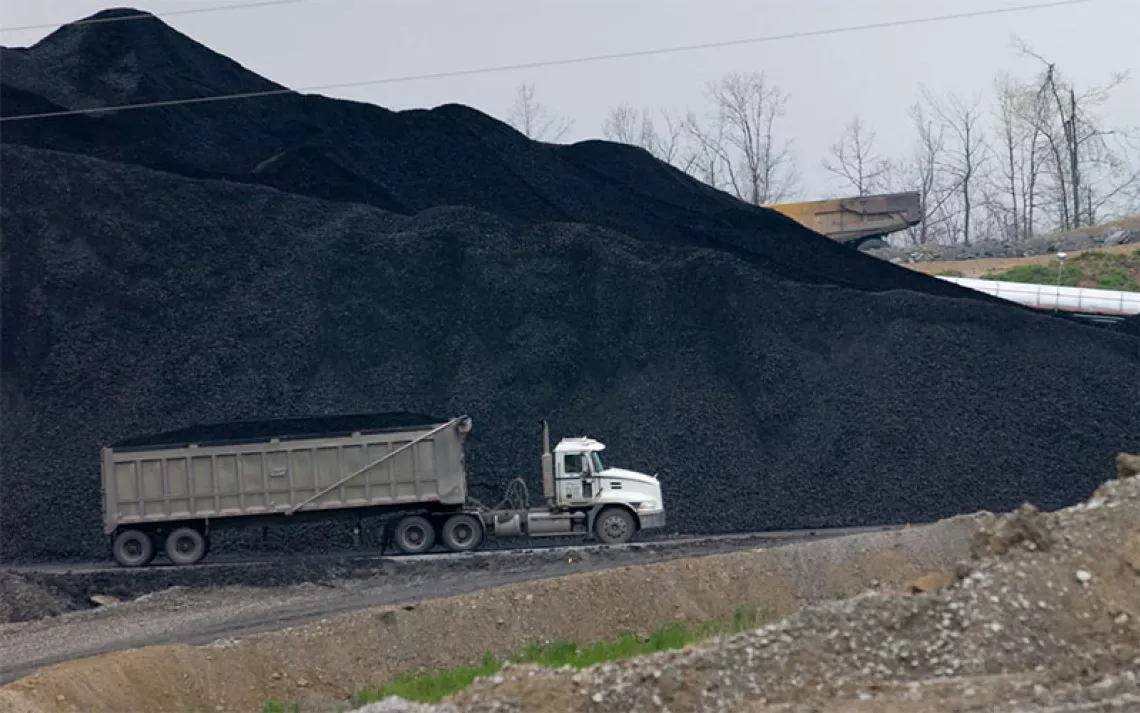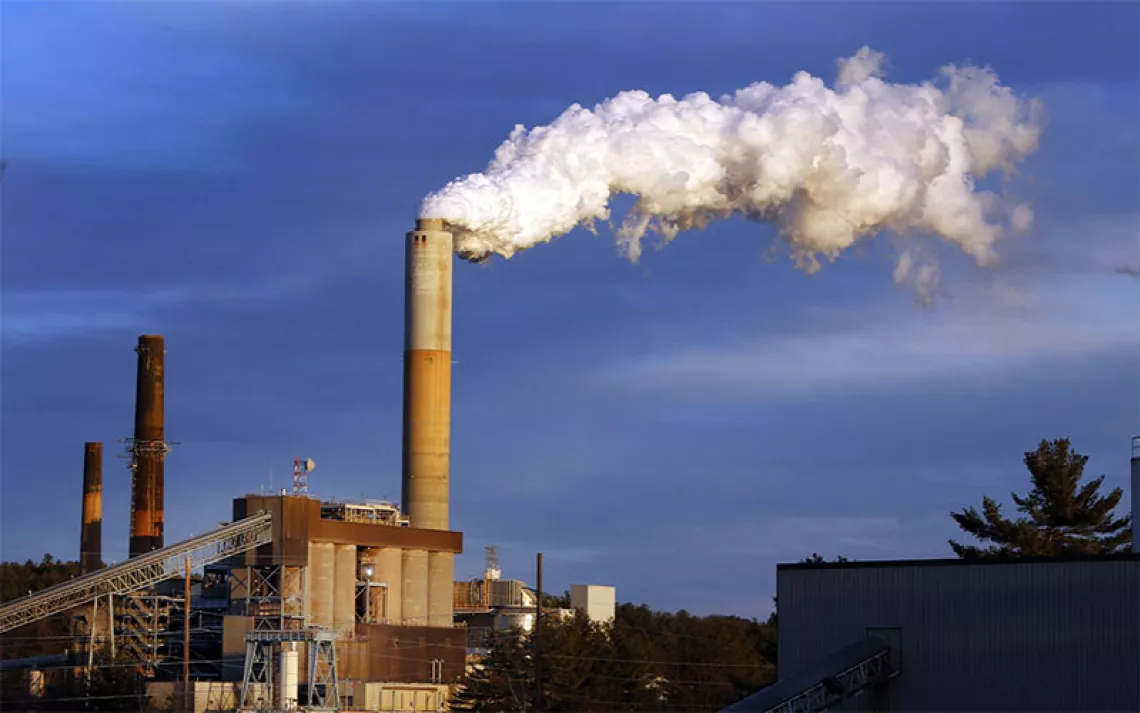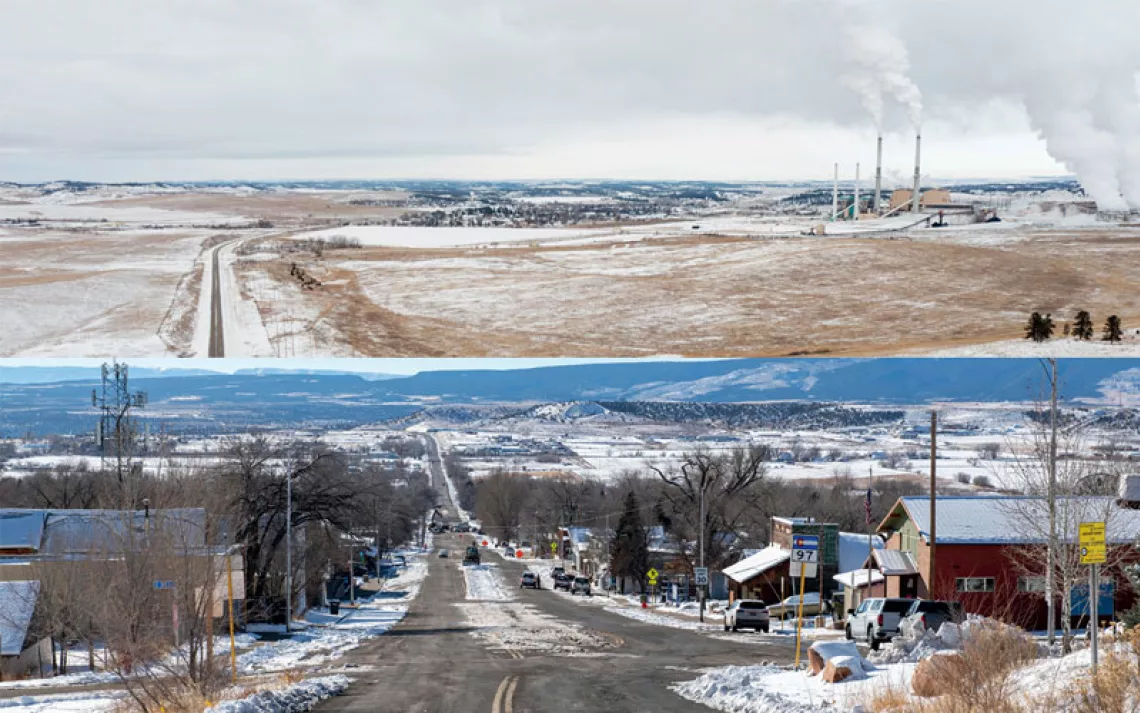Beyond the War on Coal
“From the Ashes” director Michael Bonfiglio discusses the future after U.S. coal

Photos courtesy of RadicalMedia
Two years ago—long before coal became one of the most dominant and controversial symbols of the 2016 presidential election—Bloomberg Philanthropies approached production company RadicalMedia with the idea of creating a documentary exploring the U.S. coal mining industry. Last spring, they brought on Emmy-nominated director Michael Bonfiglio, tasked with forging a compelling story out of the multitudes of facts, statistics, and narratives underlying the declining industry.
The production team spent the next year traveling from Appalachia to the West’s Powder River Basin, and beyond, to mine coal’s effects on our economy, health, and climate. They wrapped From the Ashes just one week before its April 26 worldwide premiere at the Tribeca Film Festival, where it was introduced by New York City mayor Michael Bloomberg—a longtime supporter of the Sierra Club’s Beyond Coal campaign. The film depicts Americans across the country as they wrestle with the legacy of the coal industry, its future under the Trump administration, and the direction of U.S. energy policy.
Right before the film’s June 2 premiere in New York and California, Trump withdrew the U.S. from the Paris climate accord. So, the team tweaked the film accordingly. On Sunday, June 25, at 9/8 p.m., the final version will air globally on National Geographic; audiences in 171 countries will be privy to this intimate glimpse into the cultural zeitgeist that is coal.
From the Ashes highlights the complexity of coal by shedding light on the lived experiences of those closest to it. Viewers meet the spouse of a laid-off coal worker in West Virginia who, while far from identifying as a leftie treehugger, knows that the drinking water in her home isn’t safe, as mountaintop removal rages nearby. The film analyzes how, for more than a century, mining and energy companies have been privatizing coal's profits, while socializing its costs. It features economic development incubators in rural Appalachia, as well as the Sierra Club’s Beyond Coal campaign director Mary Anne Hitt, a West Virginian, discussing ways in which we as a society might chart a path forward. It also showcases beautiful American landscapes, underscored by original compositions from Mark Orton, known for scoring 2013’s Nebraska.
“No matter where your political allegiances lie, or how much of an environmentalist you do or don’t identify as, when you see real people being poisoned because of an outdated form of energy, most people, we hope, will come away, saying, ‘We’ve got to do better—for our public health, our economy, and our children,’” sys Bonfiglio.
Sierra recently chatted with the director about exactly how we can do better, and also about the challenges of capturing such a divisive hot-button on film.
Sierra: Who was your target audience?
Bonfiglio: That was the big question. A lot of films that are issue-oriented tend to preach to the choir, which can be wonderful—you can galvanize your base and arm people with information, and just energize them. But, we decided to go for as broad of an audience as possible, because we were hoping to reach people who may not agree with the central premise of the film—which is that coal is a 19th-century technology that is now totally out of place. Regardless of where you as an audience member stand, we want you to see something that shifts your thinking a little bit—whether it reinforces things you already knew and felt, or else introduces you to the multitude of reasons why coal is a thing of the past.
Until watching this film, I didn’t realize the extent to which coal companies secured monopolies over Appalachian economies—leaving residents with virtually no other choice of employment.
Economic diversification in coal country is a really important conversation we wanted to address. One of the things that was really important to me was pointing out the fact that there are roughly 51,000 coal miners in the country—more people are employed by Whole Foods. One point of view is, “Tough luck guys, it’s a small number; sorry, but you’re out of work.” The other way to look at it is, “Hey, that’s not that many people that we as a nation can pay back for the sacrifice and contribution they’ve made to our economy for generations, by investing in these communities’ economic diversification.”
Nobody wants to be told that what they do for a living, how they put food on their table, is bad for the world. And if you’re not given any other choice, it certainly affects the way you look at an issue. But it’s not an impossible task to provide good employment for people by investing in initiatives like Coalfield Development, which creates opportunities for artisans, entrepreneurship, and tradespeople in West Virginia. It’s not charity—it’s about trying to build for-profit enterprises, and encouraging other industries to locate in Appalachia, and taking advantage of the incredible opportunities that renewable energy will and can provide for workers all across the country. We need to be encouraging the economic growth that transition can bring to the nation.

Deborah Graham, a resident of Salisbury, North Carolina, holds up a notice about contaminated drinking water, in the wake of 2014's massive spill of coal ash into the nearby Dan River.
Tell me about your research process into the coal industry and its surrounding issues.
I’m an environmentalist, and I’m passionate about all those issues, but I didn’t know very much about coal itself when the idea was first presented to me. At first, I was all, “It’s a rock; it’s boring” [laughs], but as I became more educated about the issue, I realized that from this little rock, not only have economies and nations been built, but lives are being affected, because currently, people are dying because of this. This rock is the biggest contributor to climate change. Of all the things that are contributing to climate change, eliminating coal from our energy sector would have the most enormous impact. The chunk of CO2 emissions from coal, in comparison to how useful it is nowadays, was very surprising to me. If you’re tackling a big problem, you go after the low-hanging fruit first, and that’s what the coal industry is—the easiest thing to eliminate. In the same breath, however, we need to take care of the people who’ve been working in those industries, by diversifying the economies that have consistently been monopolized by the coal industry.
Tell me about your on-screen approach to climate change.
We tried not to focus on the climate, because it’s so polarizing. In the world of this film, it’s fine if you don’t believe what all the scientists are saying. We wanted to emphasize all the other reasons why we need to be looking at a future that’s moved beyond coal. So, we focused on the public health issues, and the economic issues. We tried to present the issues and arguments from as many sides as we could, and explore as many points of view as possible.
You started working on this film before the 2016 presidential election. Did the outcome change the course of the film?
Yes and no. Like almost everyone else in the country and on the planet, we anticipated a different outcome. Originally, I think the tone of the film, which we didn’t abandon at all, was going to be a little more of a reassurance: “Hey, this is happening. Coal is going away naturally, primarily because of market forces, and for a plethora of other reasons; it needs to." So we’d initially envisioned our message as being, “Hey, it’s gonna be okay—this is actually a great opportunity for a healthier, better, more prosperous society.” And that’s still very much present in the film, but the events of the election forced us to look at some of the negative things that are happening, such as the cancellation of the Stream Protection Rule and our withdrawal from the Paris climate agreement, and to really give the issue more urgency.
So I think the message that developed from there is that it doesn’t matter what Trump and Pruitt and all these people do. Well, it certainly does in the short term—especially in terms of public health! But in terms of the larger climate, those decisions aren’t being made by the federal government; they’re being made by municipalities and corporations and other bodies that are saying, by and large, “We want to transition to renewable energy! We don’t want to burn coal." Those are the forces that are going to allow us to avoid climate catastrophe. The idiocy of the federal government under this current administration is simply delaying the inevitable. And along the way, they’re continuing to con people into thinking that coal is going to come back. It’s not. The people in power need to level with the American people, and invest in alternatives, and provide incentives for this inevitable transition. Because we can either be left behind while the rest of the world passes us by, or we can be innovators, and embrace the fact that over the past 10 years, renewables have plummeted in cost. Municipalities are saying, “We don’t care about the treehugger leftie element of this; we’re doing this because it’s cheaper. If the byproduct is that our air and water is no longer poisoning us—and even if we don’t believe that climate change is caused by humans—we don’t really care; we’re getting cheaper energy. What’s the downside?"
On the spectrum between objectivity and advocacy, where do you see this film falling?
I don’t think there’s any such thing as a completely objective documentary. We tell ourselves there is, but any time you make an edit, or point a camera in a certain direction, a choice is being made. So, I don’t want to pretend this film doesn’t have an agenda. Its biggest agenda is to educate people about issues that I think most of us don’t think about on a daily basis—like where, when you turn on a light switch, that electricity is coming from, or how it’s generated. So we’re hoping the film helps people to think about that a bit, and decide for themselves what we should be doing about our electricity, and where it comes from.
Above all, we hope this film can educate people about an issue they may know nothing about. Or, if they know a lot about it, we’re hoping the film will encourage them to look at it a little differently. We couldn’t have anticipated what a big deal coal would become in the course of the campaign and election, but since it has, we hope we can talk about the issue with some real, hard facts and information, with some human stories, to help audiences better understand the impact at local levels.
What was the most challenging aspect of making this film?
Aside from our pretty insane production schedule—we were meeting with people all over the country—the challenge was in packing in as many facts as we could, while still keeping the information digestible and palatable, and the film entertaining. We constantly asked ourselves, “Why is this a film instead of a magazine article?” We tried to craft it in such a way that you could relate to and identify with the characters, and connect to stories that have a visual and atmospheric component. Because the film is packed with information and stats and facts and figures—it needed to not be a bunch of work to sit through. You’ve still gotta bring your brain, but hopefully we’ve made it as easy as we could.
Did you encounter any challenges finding your sources?
A lot of people we approached said no. We couldn’t even get anyone from the main trade organization that represents the coal industry. It was very difficult to get people to talk to us, but the ones who did, I think, were willing to do so because we said, “Regardless of what side you’re on, we want to hear your voice.” It’s so important to talk to each other, and understand where we’re coming from—this is not an issue that’s going to get solved by one side steamrolling the other, as we’re seeing right now. It doesn’t work. So by showing multiple sides to the issue, I hope people can walk away with the understanding that we can do things differently, and that there’s incredible opportunity in doing so. We can be a stronger, more economically robust, healthier, and cleaner nation if we can look at these things not only through our own point of view, but that of other people. Hopefully, the film will help contribute to that dialogue.
What’s audience reception been like? Are you experiencing any opposition?
No, people have been incredibly receptive. I think that by and large, people appreciate that we’re not trying to denigrate legitimate points of view. It’s one thing to be critical of someone like Trump, who is lying to people, and who doesn’t have any skin in the game. It’s another to be critical of an out-of-work coal miner just trying to do what we’re all trying to do—live their life and provide for their families. I have no problem doing the former—criticizing a con artist fraud like Trump. But when you’re talking to a regular person trying to do their best, you can’t criticize that. You have to listen. So, I think people have responded positively to the fact we’re giving multiple points of view their due, while also offering alternatives that don’t leave people out in the cold. There’s been a false narrative that we have to have either jobs and a healthy economy or a healthy planet. I think it’s the opposite. In the film, West Virginian officials admit that even in coal’s heyday, West Virginia was still in the bottom five percent of the U.S. economy.

Retired coal miner Charles “Hawkeye” Dixon discusses jobs in the energy industry among peers.
Are you hoping to inspire any direct action? What can concerned viewers do?
I hope it makes people empathize more, and also contact their representatives, and their local utilities, to figure out where their energy comes from, and if there’s an alternative to sign up for. Here where I live in New York, it takes 30 seconds, through ComEd, to switch to a cleaner option. And if your utility doesn’t provide an alternative to fossil fuels, I hope you tell them you want that! On our website, viewers can check out all kinds of information and things they can do. There’s also a Crowdrise campaign that’s been launched to benefit Coalfield Development and other economic diversification efforts in coal country—Bloomberg is matching all donations to that campaign, up to three million dollars. So, people can directly support the great work that these people are doing in coal country to provide alternative employment for those who are out of work, or seeking work outside of the coal industry.
 The Magazine of The Sierra Club
The Magazine of The Sierra Club



